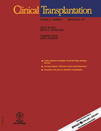Assessing elements of informed consent among living donors
Conflict of interest: None.
Abstract
Valapour M, Kahn JP, Bailey RF, Matas AJ. Assessing elements of informed consent among living donors. Clin Transplant 2011: 25: 185–190. © 2010 John Wiley & Sons A/S.
Abstract: Living organ donors – 50% of solid organ donors in the United States – represent a unique population who accept medical risk for the benefit of another. One of the main justifications for this practice has been respect for donor autonomy, as realized through informed consent. In this retrospective study of living donors, we investigate two key criteria of informed consent: (i) depth of understanding and (ii) degree of voluntariness. In our survey of 262 living kidney donors 2–40 months post-donation, we found that more than 90% understood the effects of living donation on recipient outcomes, the screening process, and the short-term medical risks of donation. In contrast, only 69% understood the psychological risks of donation; 52% the long-term medical risks of donation; and 32% the financial risks of donation. Understanding the effects of living donation on recipient outcomes was the only factor that would affect donors’ decision to donate again. A total of 40% of donors reported feeling some pressure to donate. Donors who are related to the recipient were more likely to report feeling pressure to donate. We conclude that more studies of informed consent are needed to identify factors that may compromise the validity of informed consent.




